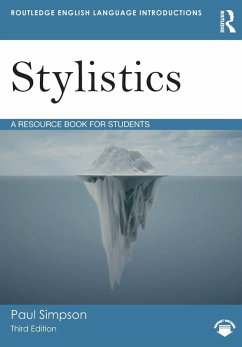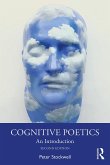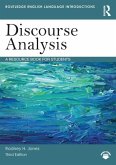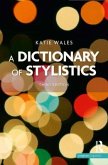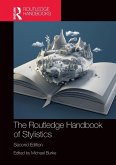- Broschiertes Buch
- Merkliste
- Auf die Merkliste
- Bewerten Bewerten
- Teilen
- Produkt teilen
- Produkterinnerung
- Produkterinnerung
Written in a clear and accessible style, Stylistics, Third Edition is a comprehensive resource which covers all the major theories, concepts and methods required for the investigation of language in literature.
Andere Kunden interessierten sich auch für
![Stylistics Stylistics]() Paul Simpson (UK University of Liverpool)Stylistics53,99 €
Paul Simpson (UK University of Liverpool)Stylistics53,99 €![Researching Stylistics Researching Stylistics]() Furzeen AhmedResearching Stylistics38,99 €
Furzeen AhmedResearching Stylistics38,99 €![Cognitive Poetics Cognitive Poetics]() Peter StockwellCognitive Poetics43,99 €
Peter StockwellCognitive Poetics43,99 €![Discourse Analysis Discourse Analysis]() Rodney H. JonesDiscourse Analysis144,99 €
Rodney H. JonesDiscourse Analysis144,99 €![Discourse Analysis Discourse Analysis]() Rodney H. JonesDiscourse Analysis41,99 €
Rodney H. JonesDiscourse Analysis41,99 €![A Dictionary of Stylistics A Dictionary of Stylistics]() Katie WalesA Dictionary of Stylistics47,99 €
Katie WalesA Dictionary of Stylistics47,99 €![The Routledge Handbook of Stylistics The Routledge Handbook of Stylistics]() The Routledge Handbook of Stylistics47,99 €
The Routledge Handbook of Stylistics47,99 €-
-
-
Written in a clear and accessible style, Stylistics, Third Edition is a comprehensive resource which covers all the major theories, concepts and methods required for the investigation of language in literature.
Produktdetails
- Produktdetails
- Routledge English Language Introductions
- Verlag: Taylor & Francis Ltd
- 3 ed
- Seitenzahl: 338
- Erscheinungstermin: 28. Oktober 2025
- Englisch
- Abmessung: 244mm x 170mm x 18mm
- Gewicht: 600g
- ISBN-13: 9781032217536
- ISBN-10: 1032217537
- Artikelnr.: 73789758
- Herstellerkennzeichnung
- Libri GmbH
- Europaallee 1
- 36244 Bad Hersfeld
- gpsr@libri.de
- Routledge English Language Introductions
- Verlag: Taylor & Francis Ltd
- 3 ed
- Seitenzahl: 338
- Erscheinungstermin: 28. Oktober 2025
- Englisch
- Abmessung: 244mm x 170mm x 18mm
- Gewicht: 600g
- ISBN-13: 9781032217536
- ISBN-10: 1032217537
- Artikelnr.: 73789758
- Herstellerkennzeichnung
- Libri GmbH
- Europaallee 1
- 36244 Bad Hersfeld
- gpsr@libri.de
Paul Simpson is the Baines Professor of English Language in the Department of English at Liverpool University, UK.
Preface A Introduction: key concepts in stylistics 1 What is stylistics? 2
Stylistics and levels of language 3 Grammar and style 4 Rhythm and metre 5
Narrative stylistics 6 Style as choice 7 Style and point of view 8
Representing speech and thought 9 Dialogue and discourse 10 Cognitive
stylistics 11 Metaphor and metonymy 12 Corpus stylistics B Development:
doing stylistics 1 Developments in stylistics 2 Levels of language at work:
an example from poetry 3 Sentence styles: development and illustration 4
Interpreting patterns of sound 5 Developments in structural narratology 6
Style and transitivity 7 Approaches to point of view 8 Techniques of speech
and thought presentation 9 Dialogue in drama 10 Developments in cognitive
stylistics 11 Styles of metaphor 12 Developments in corpus stylistics C
Exploration: investigating style 1 Is there a 'literary language'? 2 Style,
register and dialect 3 Grammar and genre: a short study in Imagism 4
Stylistics and re-writing: an example from prose fiction 5 A
sociolinguistic model of narrative 6 Transitivity, characterisation and
literary genre 7 Exploring point of view in narrative fiction 8 A workshop
on speech and thought presentation 9 Exploring dialogue 10 Cognitive
stylistics at work 11 Exploring metaphors in different kinds of texts 12
Using corpora in stylistic analysis D Extension: readings in stylistics 1
Stylistics and the teaching of literature (Henry Widdowson) 2 Style and
verbal play (Katie Wales) 3 Teaching grammar and style (Ronald Carter) 4
Sound, style and onomatopoeia (Derek Attridge) 5 Style shifting and
Jamaican Creole (Naomi Adam) 6 Transitivity at work (Deirdre Burton) 7
Style variation and point of view (Mick Short) 8 The effects of free
indirect discourse (Joe Bray) 9 Multimodal analysis and the stylistics of
drama (Dan McIntyre) 10 From lexical semantics to conceptual integration
theory (Patricia Canning and Paul Simpson) 11 Cognitive stylistics and the
theory of metaphor (Peter Stockwell) (Suzanne McClure) Further reading
References
Stylistics and levels of language 3 Grammar and style 4 Rhythm and metre 5
Narrative stylistics 6 Style as choice 7 Style and point of view 8
Representing speech and thought 9 Dialogue and discourse 10 Cognitive
stylistics 11 Metaphor and metonymy 12 Corpus stylistics B Development:
doing stylistics 1 Developments in stylistics 2 Levels of language at work:
an example from poetry 3 Sentence styles: development and illustration 4
Interpreting patterns of sound 5 Developments in structural narratology 6
Style and transitivity 7 Approaches to point of view 8 Techniques of speech
and thought presentation 9 Dialogue in drama 10 Developments in cognitive
stylistics 11 Styles of metaphor 12 Developments in corpus stylistics C
Exploration: investigating style 1 Is there a 'literary language'? 2 Style,
register and dialect 3 Grammar and genre: a short study in Imagism 4
Stylistics and re-writing: an example from prose fiction 5 A
sociolinguistic model of narrative 6 Transitivity, characterisation and
literary genre 7 Exploring point of view in narrative fiction 8 A workshop
on speech and thought presentation 9 Exploring dialogue 10 Cognitive
stylistics at work 11 Exploring metaphors in different kinds of texts 12
Using corpora in stylistic analysis D Extension: readings in stylistics 1
Stylistics and the teaching of literature (Henry Widdowson) 2 Style and
verbal play (Katie Wales) 3 Teaching grammar and style (Ronald Carter) 4
Sound, style and onomatopoeia (Derek Attridge) 5 Style shifting and
Jamaican Creole (Naomi Adam) 6 Transitivity at work (Deirdre Burton) 7
Style variation and point of view (Mick Short) 8 The effects of free
indirect discourse (Joe Bray) 9 Multimodal analysis and the stylistics of
drama (Dan McIntyre) 10 From lexical semantics to conceptual integration
theory (Patricia Canning and Paul Simpson) 11 Cognitive stylistics and the
theory of metaphor (Peter Stockwell) (Suzanne McClure) Further reading
References
Preface A Introduction: key concepts in stylistics 1 What is stylistics? 2
Stylistics and levels of language 3 Grammar and style 4 Rhythm and metre 5
Narrative stylistics 6 Style as choice 7 Style and point of view 8
Representing speech and thought 9 Dialogue and discourse 10 Cognitive
stylistics 11 Metaphor and metonymy 12 Corpus stylistics B Development:
doing stylistics 1 Developments in stylistics 2 Levels of language at work:
an example from poetry 3 Sentence styles: development and illustration 4
Interpreting patterns of sound 5 Developments in structural narratology 6
Style and transitivity 7 Approaches to point of view 8 Techniques of speech
and thought presentation 9 Dialogue in drama 10 Developments in cognitive
stylistics 11 Styles of metaphor 12 Developments in corpus stylistics C
Exploration: investigating style 1 Is there a 'literary language'? 2 Style,
register and dialect 3 Grammar and genre: a short study in Imagism 4
Stylistics and re-writing: an example from prose fiction 5 A
sociolinguistic model of narrative 6 Transitivity, characterisation and
literary genre 7 Exploring point of view in narrative fiction 8 A workshop
on speech and thought presentation 9 Exploring dialogue 10 Cognitive
stylistics at work 11 Exploring metaphors in different kinds of texts 12
Using corpora in stylistic analysis D Extension: readings in stylistics 1
Stylistics and the teaching of literature (Henry Widdowson) 2 Style and
verbal play (Katie Wales) 3 Teaching grammar and style (Ronald Carter) 4
Sound, style and onomatopoeia (Derek Attridge) 5 Style shifting and
Jamaican Creole (Naomi Adam) 6 Transitivity at work (Deirdre Burton) 7
Style variation and point of view (Mick Short) 8 The effects of free
indirect discourse (Joe Bray) 9 Multimodal analysis and the stylistics of
drama (Dan McIntyre) 10 From lexical semantics to conceptual integration
theory (Patricia Canning and Paul Simpson) 11 Cognitive stylistics and the
theory of metaphor (Peter Stockwell) (Suzanne McClure) Further reading
References
Stylistics and levels of language 3 Grammar and style 4 Rhythm and metre 5
Narrative stylistics 6 Style as choice 7 Style and point of view 8
Representing speech and thought 9 Dialogue and discourse 10 Cognitive
stylistics 11 Metaphor and metonymy 12 Corpus stylistics B Development:
doing stylistics 1 Developments in stylistics 2 Levels of language at work:
an example from poetry 3 Sentence styles: development and illustration 4
Interpreting patterns of sound 5 Developments in structural narratology 6
Style and transitivity 7 Approaches to point of view 8 Techniques of speech
and thought presentation 9 Dialogue in drama 10 Developments in cognitive
stylistics 11 Styles of metaphor 12 Developments in corpus stylistics C
Exploration: investigating style 1 Is there a 'literary language'? 2 Style,
register and dialect 3 Grammar and genre: a short study in Imagism 4
Stylistics and re-writing: an example from prose fiction 5 A
sociolinguistic model of narrative 6 Transitivity, characterisation and
literary genre 7 Exploring point of view in narrative fiction 8 A workshop
on speech and thought presentation 9 Exploring dialogue 10 Cognitive
stylistics at work 11 Exploring metaphors in different kinds of texts 12
Using corpora in stylistic analysis D Extension: readings in stylistics 1
Stylistics and the teaching of literature (Henry Widdowson) 2 Style and
verbal play (Katie Wales) 3 Teaching grammar and style (Ronald Carter) 4
Sound, style and onomatopoeia (Derek Attridge) 5 Style shifting and
Jamaican Creole (Naomi Adam) 6 Transitivity at work (Deirdre Burton) 7
Style variation and point of view (Mick Short) 8 The effects of free
indirect discourse (Joe Bray) 9 Multimodal analysis and the stylistics of
drama (Dan McIntyre) 10 From lexical semantics to conceptual integration
theory (Patricia Canning and Paul Simpson) 11 Cognitive stylistics and the
theory of metaphor (Peter Stockwell) (Suzanne McClure) Further reading
References

